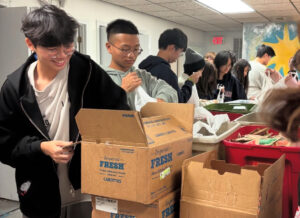By now we all know to look out for the fine print on our food packaging: contains milk products or made in a facility that processes nuts. Most of us have a friend with a food allergy, in fact, according to FARE (Food Allergy Research and Education), 4% of adults and 8% of children in the US have a food allergy that can have any range of symptoms, from mild to life-threatening.
Hundreds of thousands of hospital visits every year can be attributed to the more dangerous reactions, yet “people with allergies aren’t necessarily taking the precautions that they probably should be,” according to BHS senior Aiden Comeau, founder of the Food Allergy Club. Comeau and co-founder Michael Hoang started the club during the 2018-19 school year in order to change the schoolwide attitude towards food allergies. Both felt that the student body has been too casual about allergies, causing people to ignore or forget the potential severity a reaction could have. Safety is a big issue, explains Comeau, mostly because there is “just a general culture of not understanding” how serious a food allergy can be. The Food Allergy Club hopes to change that.
Safety is not the only piece of the problem that the Food Allergy Club hopes to address. Many students have experienced varying degrees of bullying or teasing from their classmates as a result of having an allergy. This is especially an issue among younger grades, but the issue remains even as students move on to high school. As Michael Hoang explains from his own experience, “I didn’t want to be different, stand out, or look weird… [but] I really needed to realize that I needed to prioritize my safety over what other people thought of me.” This fear of isolation, which has been reported by students of all ages, not only causes other students to view food allergies as a smaller issue than it is, but also can cause students to prioritize their appearances over their own safety. Hoang hopes to “spread awareness to the younger kids” because he is aware that middle school students may still have a “hard time dealing with the issues” that spring from their classmates misunderstanding how serious their food allergies can be.
Comeau and Hoang’s club, advised by school nurse Mrs. Mastrodicasa, was only recently created but has already become active around BHS. They launched last May by recognizing the national Food Allergy Awareness Week: they put up posters, set up a table outside the Commons, and organized activities such as the “wear teal” day and the “live the life of someone with a food allergy” day. The club has also raised money to donate to FARE in the hopes that they can also a larger impact beyond just BHS.
In the future, the Food Allergy club intends to both continue their past successes and to cause more change. Their biggest plan at the moment is to work with Corey Parker, dean of wellness, to create a lesson to be taught to future wellness classes. They hope to incorporate this lesson on food allergies into the wellness curriculum, so that every incoming BHS student is able to learn a little more about food allergies and how these allergies affect themselves or their classmates. Allergies are naturally “a big part of your life,” says Comeau when asked about his own experience having a food allergy, “but just because it necessitates some seriousness” in keeping yourself safe. It is this seriousness that the co-founders of the BHS Food Allergy Club hope to explain to the student body in the future. As with any issue, the message is much the same: “Just try to respect the differences in other people,” Hoang urges fellow students. “Try to understand where other people are coming from. We’d all get along a lot better, and be a lot safer.”
Listed here are some more resources for the curious reader!
To find out the basic science behind allergies: https://www.foodallergy.org/life-with-food-allergies/food-allergy-101/what-causes-food-allergies
To look at further facts and statistics: https://www.foodallergy.org/sites/default/files/migrated-files/file/facts-stats.pdf
Or to find out the difference between an allergy and an intolerance: https://www.medicalnewstoday.com/articles/263965.php











